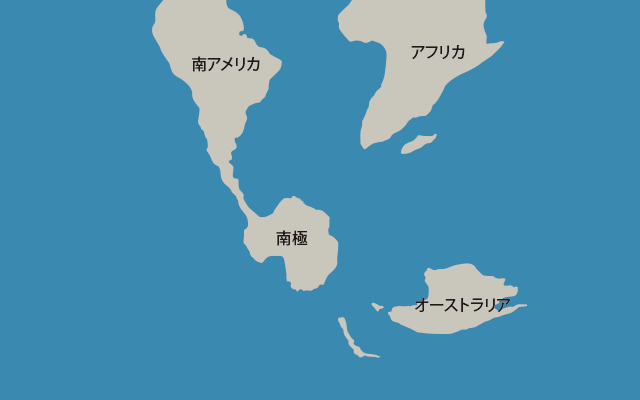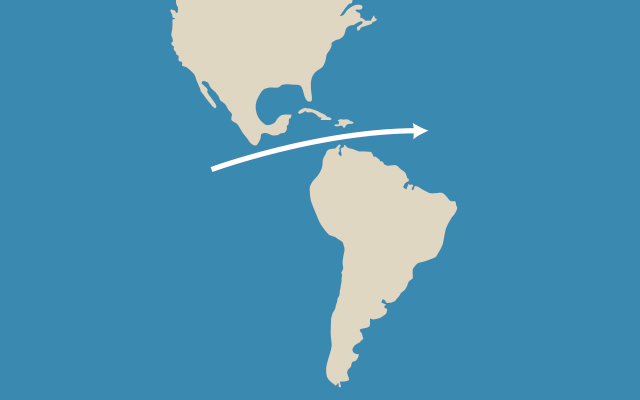
ドレーク海峡の成立
Drake Strait formation

パナマ地峡の成立
Isthmus of Panama formation
新生代(約6600万年前〜現代)は生物の観点から哺乳類の時代と呼ばれる一方で、気候の観点からは「寒冷化の時代」と呼ばれている。新生代の気候には幾つかの変動パターンが存在するが(☞2ページ)、ここではテクトニクス・スケールと呼ばれる最も大きな変動パターンに注目して紹介する。
寒冷化は新生代の前(中生代白亜紀の末)から既に始まっていたものの、それでも新生代の当初はまだ暖かった。しかし、気候はおよそ5000万年ほど前より寒冷傾向に転じて徐々に氷期モードへと移行し、4000〜3000万年前には南極大陸において大陸氷床の形成が始まった。一方の北半球では、おそらくは数百万年前より規模の小さな大陸氷床が出現していたが、特に約275万年前からは海にまで張り出すほど大きな大陸氷床が北アメリカやヨーロッパ、およびシベリアの台地を度々覆うようになった。
これらの寒冷化は、プレート・テクトニクスと呼ばれる現象(プレート運動によって大陸が移動して山脈がつくられる現象:☞E1_6、E2_6)に関係している。約5000万年前の寒冷化には、インド大陸とユーラシア大陸の衝突によって始まったヒマラヤ山脈の形成が関与した。このことは寒冷化以外にも多くの現象を伴ったので、詳しくは後ほど改めて説明する(☞E6_3ページ)。約4000〜3000万年前の南極大陸の氷床の出現は、周辺大陸からの独立によって引き起こされた。すなわち、南極大陸から初めにオーストラリア大陸、続いて南米大陸が離れたことで、南極大陸の周りを一周する冷たい海流(南極環流)が形成された。それによって南極大陸が熱的に孤立し、寒冷化が促進されたために大陸氷床が発達したのである。また、おおよそ275万年前の北半球の大規模な大陸氷床の発達には、北米と南米の間にあるパナマ地峡の成立が関わった。氷の塊である氷床が発達するためには、大量の雪が陸上に降り積もる必要がある。パナマ地峡といった障壁ができたことで、それまで太平洋に流れ込んでいた湿度に富んだ海流が大西洋を北上し、北アメリカやヨーロッパに雪を降らせて大陸氷床の形成を加速させたのである。
From a fauna point of view, the Cenozoic that started 66 million years ago up to modern days is called the age of mammals. However from a meteorological point of view, this period is called the "era of cooling". The Cenozoic's climate is composed of several variation patterns (☞ Page 2), but we will introduce you to the Cenozoic climate by focusing on its largest variation pattern called tectonics scale.
Although the climate started to cool down way before the Cenozoic era started, the climate was still warm at the beginning.
However, the climate turned to a colder trend about 50 million years ago, gradually shifted to a glaciation and the formation of a continental ice sheet started in Antarctica 40~30 million years ago. In the Northern hemisphere, it is possible that a small-scale continental ice sheet emerged several million years before but this small-scale continental ice sheet started veritably to grow 2.75 million years ago, expanded to the sea and was big enough to cover North America, Europe and the Siberian plateau at that time. These cooling processes are related to a phenomenon called plate tectonics (a phenomenon in which a mountain range is created when continents move due to plate tectonic: ☞E1_6、E2_6). The formation of the Himalayas mountain range, which began about 50 million years ago when the Indian subcontinent and the Eurasian continent collided, was involved in this cooling process. Besides the cooling, this was accompanied by many phenomena that will be explained in detail later (☞ E 6 _ 3 page). In fact, the emergence of a continental ice sheet over Antarctica 40~30 million years ago was due to the fact that the continent was isolated from the surrounding lands. In other words, when Antarctica split with Australia then with South America, a cold oceanic current called the Antarctic Circumpolar Current circulating around the Antarctica was born. As a result, the Antarctica was thermally isolated from the rest of the world and the continental ice sheet developed faster. On the other side, the formation of the Panama Strait roughly 2.75 Million years ago between the North and South America was involved in the development of the Northern hemisphere large continental ice sheet. Indeed, in order to develop, a continental ice sheet needs a large amount of accumulated snow on land. With the creation of a natural barrier such as the Panama isthmus, current rich in humidity that flowed until then into the Pacific Ocean continued their way northwards through the Atlantic Ocean, which accelerated the formation of the continental ice sheet over North America and Europe by bringing snow.